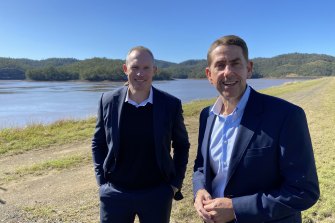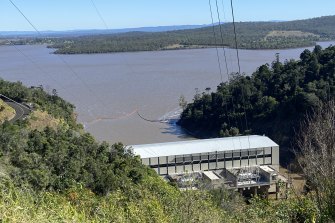Pump it up: Queensland unveils hydro power plan to reduce electricity costs
By Tony Moore
The Queensland government has made a $48 million down payment to rapidly expand hydroelectricity generation to produce lower electricity prices with lower emissions.
Queensland Treasurer Cameron Dick and Energy and Hydrogen Minister Mick de Brenni announced the investment as part of next week’s state budget, which would identify extra pumped hydro storage sites in Queensland.
The announcement came after federal Energy Minister Chris Bowen outlined a new energy transition plan that included more emphasis on pumped hydroelectricity.

Energy Minister Mick de Brenni and Treasurer Cameron Dick announce plans to boost pumped hydro energy production in Queensland in an energy switch designed to lower electricity prices.Credit:Tony Moore
Studies have identified 14 potential pumped hydro sites in Queensland.
The government believes new hydroelectricity plants could generate enough electricity by the end of the decade to cover Queensland’s daily electricity demand of more than seven gigawatts.
A pumped hydro plant generates electricity by allowing water to fall from one higher dam to a second lower dam through turbines. The water is collected and “pumped up” again to run through the turbines.

The Splityard Creek pumped hydro plant near Wivenhoe Dam.Credit:Tony Moore
Standing in front of Lake Wivenhoe’s Splityard Creek Dam, Dick said the higher dams acted as giant “batteries” for pumped hydroelectricity.
“During the day, we are producing more renewable energy than we need, and we pump water from Wivenhoe Dam up to this dam,” he said.
“Then at night when the sun is down we can drive the water down the hill again, spinning those turbines and creating renewable energy for Queenslanders.”
Dick said “storage” was the key to unlocking Queensland’s renewable energy resources in the future.
He announced $13 million to fast-track geotechnical studies to allow the large 1.5 gigawatts Lake Borumba pumped hydro plant near Gympie to accelerate its construction start date.
A further $35 million will allow studies on 12 different sites throughout for a single new pumped hydro plant or several pumped hydro plants to provide an additional five to seven gigawatts of electricity.
De Brenni said Friday’s announcement set out a new path to storing renewable energy, in addition to industrial-sized and household solar energy batteries.
“Cynics say that sometimes the sun doesn’t shine, and that sometimes it doesn’t rain, but as a civilisation we do pretty well at storing water.
“If we can store that [energy] in one or more of these new megaprojects that means we can power the entire state from hydroelectric energy, making sure that we put downward pressure on the cost of living for Queenslanders,” he said.
Little energy production in Queensland comes from hydroelectricity, despite a promise that 50 per cent of Queensland’s energy production by 2030 would come from renewable energy.
About 23 per cent of Queensland’s electricity is produced by renewable energy.
Queensland has one small pumped hydro plant – the 570-megawatt plant at Splityard Creek, and second about to begin producing 250 megawatts at Kidston Dam in far north Queensland.
Queensland’s first residential-scale pumped hydro plant will be built at Lake Borumba, close to Gympie, and power 700,000 homes by 2028-29, de Brenni said.
He said by 2024 there would be 10 additional solar farms and five new wind farms.